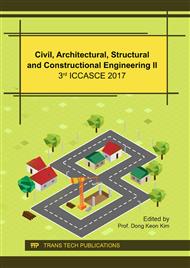[1]
Y. L. X. Li, The Green Ecological Environment in Shanghai Free Trade Area, Nat. Envir. Pollut. Tech. 15(2) (2016) 755-760.
Google Scholar
[2]
X. Xi, R. Sioshansi, V. Marano, A stochastic dynamic programming model for co-optimization of distributed energy storage. Energ. Syst. 5(3) (2014) 475-505.
DOI: 10.1007/s12667-013-0100-6
Google Scholar
[3]
X. Lu, K. Sun, J. M. Guerrero, J. C. Vasquez & L. Huang, State-of-charge balance using adaptive droop control for distributed energy storage systems in DC microgrid applications. Ind. Electr. IEEE Trans. 61(6) (2014) 2804-2815.
DOI: 10.1109/tie.2013.2279374
Google Scholar
[4]
Y. L. X. Li, The Green Historic District Environment Protection and Utilization, Nat. Envir. Pollut. Tech. 15(3) (2016) 997-1004.
Google Scholar
[5]
J. P. Praene, M. David, F. Sinama, D. Morau, & O. Marc, Renewable energy: Progressing towards a net zero energy island, the case of Reunion Island. Renew. Sustain. Energ. Rev. 16(1) (2012) 426-442.
DOI: 10.1016/j.rser.2011.08.007
Google Scholar
[6]
P. Raman, S. Mande & V. V. N. Kishore, A passive solar system for thermal comfort conditioning of buildings in composite climates. Solar Energ. 70(4) (2001) 319-329.
DOI: 10.1016/s0038-092x(00)00147-x
Google Scholar
[7]
L. Yang, Green building design: Building energy efficiency, Shanghai: Tongji University Press, (2016).
Google Scholar
[8]
N. Susheela, & M. K. Sharp, Heat pipe augmented passive solar system for heating of buildings. J. Energ. Eng. 127(1) (2001) 18-36.
DOI: 10.1061/(asce)0733-9402(2001)127:1(18)
Google Scholar
[9]
P. Kumar, M. Ketzel, S. Vardoulakis, L. Pirjola, & R. Britter, Dynamics and dispersion modelling of nanoparticles from road traffic in the urban atmospheric environment—a review. J. Aeros. Sci. 42(9) (2011) 580-603.
DOI: 10.1016/j.jaerosci.2011.06.001
Google Scholar
[10]
L. Yang, Q. Feng. Research on the Green Wind Environment Based on Numerical Simulation, Nat. Envir. Pollut. Tech. 15(2) (2016), 767-772.
Google Scholar
[11]
C. K. Chan & X. Yao, Air pollution in mega cities in China. Atmosph. Envir. 42(1) (2008) 1-42.
Google Scholar
[12]
D. Tang, T. Y. Li, J. C. Chow, S. U. Kulkarni, J. G. Watson, S. S. H. Ho. & F. Perera, Air pollution effects on fetal and child development: A cohort comparison in China, (2014).
DOI: 10.1016/j.envpol.2013.10.019
Google Scholar
[13]
F. Qian, L. Yang, Research on the Sustainability of Urbanization in China, Appl. Mech. Mater. 851 (2016) 664-667.
Google Scholar
[14]
I. D. Stewart & T. R. Oke, Local climate zones for urban temperature studies. Bull. Am. Meteorol. Soc. 93(12) (2012) 1879-(1900).
DOI: 10.1175/bams-d-11-00019.1
Google Scholar
[15]
V. G. Mitchell, R. G. Mein & T. A. McMahon, Modelling the urban water cycle. Environ. Model. Software, 16(7) (2001) 615-629.
DOI: 10.1016/s1364-8152(01)00029-9
Google Scholar
[16]
L. Yang, Green building design: Wind environment of building, Shanghai: Tongji University Press, (2014).
Google Scholar
[17]
M. Lundin & G. M. Morrison, A life cycle assessment based procedure for development of environmental sustainability indicators for urban water systems. Urb. Water, 4(2) (2002) 145-152.
DOI: 10.1016/s1462-0758(02)00015-8
Google Scholar
[18]
P. H. Verburg, W. Soepboer, A. Veldkamp, R. Limpiada, V. Espaldon & S. S. Mastura, Modeling the spatial dynamics of regional land use: the CLUE-S model. Envir. Manag. 30(3) (2002) 391-405.
DOI: 10.1007/s00267-002-2630-x
Google Scholar
[19]
C. B. Cooper, J. Dickinson, T. Phillips & R. Bonney, Citizen science as a tool for conservation in residential ecosystems. Ecol. Soc. 12(2) (2007) 11.
DOI: 10.5751/es-02197-120211
Google Scholar
[20]
D. Frye, From locus publicus to locus sanctus: Justice and Sacred Space in Merovingian Gaul. Nottingham medieval studies, 47(1) (2003) 1-20.
DOI: 10.1484/j.nms.3.344
Google Scholar
[21]
W. Rees & M. Wackernagel, Urban ecological footprints: why cities cannot be sustainable—and why they are a key to sustainability. In Urban Ecology (pp.537-555). Springer US, (2008).
DOI: 10.1007/978-0-387-73412-5_35
Google Scholar
[22]
E. L. Glaeser, M. E. Kahn & J. Rappaport, Why do the poor live in cities? The role of public transportation. J. Urb. Econ. 63(1) (2008) 1-24.
DOI: 10.1016/j.jue.2006.12.004
Google Scholar
[23]
B. Giles-Corti, M. H. Broomhall, M. Knuiman, C. Collins, K. Douglas, K. Ng. & R. J. Donovan, Increasing walking: how important is distance to, attractiveness, and size of public open space? Am. J. Prevent. Med. 28(2) (2005) 169-176.
DOI: 10.1016/j.amepre.2004.10.018
Google Scholar
[24]
P. Aspinall, S. Bell, C. Findlay, J. Wherrett & P. Travlou, Open space and social inclusion: local woodland use in central Scotland. Forestry Commission, (2004).
Google Scholar



